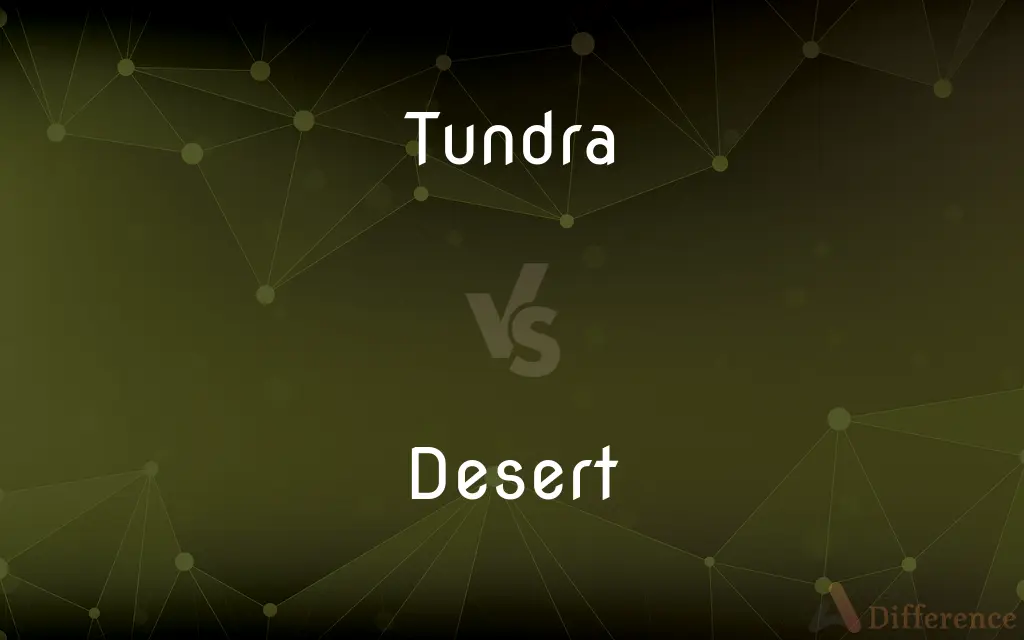Tundra vs. Desert — What's the Difference?
Edited by Tayyaba Rehman — By Maham Liaqat — Updated on April 16, 2024
Tundra regions feature cold climates and limited vegetation, primarily mosses and lichens, while deserts are characterized by their arid conditions and sparse rainfall, supporting cacti and shrubs.

Difference Between Tundra and Desert
Table of Contents
ADVERTISEMENT
Key Differences
Tundra ecosystems are found in high latitude regions where temperatures are typically below freezing for most of the year, supporting minimal plant and animal life. Deserts, on the other hand, are defined by their extreme dryness, found in both cold and hot climates, but always with low precipitation.
The soil in tundra regions is permanently frozen subsoil called permafrost, which inhibits the growth of deep-rooted plants. Whereas desert soils are usually sandy or rocky with little organic material, allowing for rapid drainage of the little moisture that falls.
Tundra vegetation consists mainly of mosses, grasses, and lichens, adapted to extreme cold and short growing seasons. Deserts support a more varied vegetation adapted to aridity, such as cacti, succulents, and hardy shrubs.
Animal life in the tundra includes species like caribou, arctic foxes, and snowy owls, which are adapted to cold, harsh conditions and migratory patterns. In contrast, desert fauna, such as reptiles, birds, and small mammals, are adapted to conserve water and avoid daytime heat.
Human habitation in tundra regions is sparse, primarily due to the harsh climate and limited resources. Conversely, many desert regions are inhabited, with communities adapted to the challenging environment through unique agricultural and water-conservation techniques.
ADVERTISEMENT
Comparison Chart
Climate
Extremely cold, with long winters
Hot or cold, but always dry
Precipitation
Low, mostly snow
Very low, rain or snow
Vegetation
Mosses, lichens, short grasses
Cacti, hardy shrubs, occasional trees
Soil
Permafrost, poor nutrients
Sandy or rocky, good drainage
Fauna
Adapted to cold (e.g., polar bears)
Adapted to dryness (e.g., snakes)
Compare with Definitions
Tundra
A biome where the tree growth is hindered by low temperatures and short growing seasons.
The Siberian tundra is home to numerous unique wildlife species.
Desert
A barren area of landscape where little precipitation occurs, thus supporting sparse vegetation.
The Sahara Desert is one of the most well-known deserts in the world.
Tundra
Dominated by mosses, lichens, and low shrubs.
Mosses in the tundra form a thick green layer over the rocks.
Desert
Typically features sand dunes, rocky plateaus, and scarce water sources.
Oasis in deserts serve as critical water sources for wildlife.
Tundra
Characterized by permafrost, soil at or below the freezing point of water.
Permafrost in tundra regions significantly affects the types of plants that can grow.
Desert
Home to specialized fauna that can survive extreme dryness.
The fennec fox, a small nocturnal animal, thrives in desert conditions.
Tundra
Hosts migratory animals adapted to cold climates.
Caribou migrate across the tundra in search of food.
Desert
Supports plants like cacti and succulents that store water.
Saguaro cacti dominate the landscape of the Sonoran Desert.
Tundra
Limited human development due to harsh living conditions.
Few indigenous communities reside in the Arctic tundra.
Desert
Inhabited by humans who have adapted traditional methods for survival.
The Bedouin tribes have lived in desert regions for centuries.
Tundra
In physical geography, tundra () is a type of biome where the tree growth is hindered by low temperatures and short growing seasons. The term tundra comes through Russian тундра (tundra) from the Kildin Sámi word тӯндар (tūndâr) meaning "uplands", "treeless mountain tract".
Desert
A desert is a barren area of landscape where little precipitation occurs and, consequently, living conditions are hostile for plant and animal life. The lack of vegetation exposes the unprotected surface of the ground to the processes of denudation.
Tundra
A treeless area beyond the timberline in high-latitude regions, having a permanently frozen subsoil and supporting low-growing vegetation such as lichens, mosses, and shrubs.
Desert
Abandon (a person, cause, or organization) in a way considered disloyal or treacherous
We feel our public representatives have deserted us
Tundra
A similar area found at high elevations.
Desert
A waterless, desolate area of land with little or no vegetation, typically one covered with sand
The desert of the Sinai peninsula is a harsh place
Drought and deforestation are turning fragile grasslands into desert
Tundra
A flat and treeless Arctic biome.
Desert
A flock of lapwings
A desert of lapwings rises from a ploughed field
Tundra
One of the level or undulating treeless plains characteristic of northern arctic regions in both hemispheres; the term is most commony associated with the arctic plains of Siberia. The tundras mark the limit of arborescent vegetation; they consist of black mucky soil with a permanently frozen subsoil, but support a dense growth of mosses and lichens, and dwarf herbs and shrubs, often showy-flowered.
Desert
Like a desert
Overgrazing has created desert conditions
Tundra
A vast treeless plain in the arctic regions between the ice cap and the tree line
Desert
A dry, often sandy region of little rainfall, extreme temperatures, and sparse vegetation.
Desert
A region of permanent cold that is largely or entirely devoid of life.
Desert
An apparently lifeless area of water.
Desert
An empty or forsaken place; a wasteland
A cultural desert.
Desert
(Archaic) A wild and uninhabited region.
Desert
Often deserts Something that is deserved or merited, especially a punishment
They got their just deserts when the scheme was finally uncovered.
Desert
The state or fact of deserving reward or punishment.
Desert
Of, relating to, characteristic of, or inhabiting a desert
Desert fauna.
Desert
Wild and uninhabited
A desert island.
Desert
To leave empty or alone; abandon.
Desert
To withdraw from, especially in spite of a responsibility or duty; forsake
Deserted her friend in a time of need.
Desert
To abandon (a military post, for example) in violation of orders or an oath.
Desert
To forsake one's duty or post, especially to be absent without leave from the armed forces with no intention of returning.
Desert
That which is deserved or merited; a just punishment or reward.
Desert
A barren area of land or desolate terrain, especially one with little water or vegetation; a wasteland.
Desert
(figuratively) Any barren place or situation.
Desert
Usually of a place: abandoned, deserted, or uninhabited.
They were marooned on a desert island in the Pacific.
Desert
To leave (anything that depends on one's presence to survive, exist, or succeed), especially when contrary to a promise or obligation; to abandon; to forsake.
You can't just drive off and desert me here, in the middle of nowhere.
Desert
To leave one's duty or post, especially to leave a military or naval unit without permission.
Anyone found deserting will be punished.
Desert
That which is deserved; the reward or the punishment justly due; claim to recompense, usually in a good sense; right to reward; merit.
According to their deserts will I judge them.
Andronicus, surnamed PiusFor many good and great deserts to Rome.
His reputation falls far below his desert.
Desert
A deserted or forsaken region; a barren tract incapable of supporting population, as the vast sand plains of Asia and Africa which are destitute of moisture and vegetation.
A dreary desert and a gloomy waste.
Desert
A tract, which may be capable of sustaining a population, but has been left unoccupied and uncultivated; a wilderness; a solitary place.
He will make her wilderness like Eden, and her desert like the garden of the Lord.
Before her extendedDreary and vast and silent, the desert of life.
Desert
Of or pertaining to a desert; forsaken; without life or cultivation; unproductive; waste; barren; wild; desolate; solitary; as, they landed on a desert island.
He . . . went aside privately into a desert place.
Full many a flower is born to blush unseen,And waste its sweetness on the desert air.
Desert
To leave (especially something which one should stay by and support); to leave in the lurch; to abandon; to forsake; - implying blame, except sometimes when used of localities; as, to desert a friend, a principle, a cause, one's country.
Desert
To abandon (the service) without leave; to forsake in violation of duty; to abscond from; as, to desert the army; to desert one's colors.
Desert
To abandon a service without leave; to quit military service without permission, before the expiration of one's term; to abscond.
The soldiers . . . deserted in numbers.
Desert
An arid region with little or no vegetation
Desert
Leave someone who needs or counts on you; leave in the lurch;
The mother deserted her children
Desert
Desert (a cause, a country or an army), often in order to join the opposing cause, country, or army;
If soldiers deserted Hitler's army, they were shot
Desert
Located in a dismal or remote area; desolate;
A desert island
A godforsaken wilderness crossroads
A wild stretch of land
Waste places
Common Curiosities
What types of vegetation are common in deserts?
Common vegetation in deserts includes cacti, succulents, and sparse shrubby trees adapted to aridity.
How do people live in the tundra?
People in the tundra adapt through practices like building insulated homes and relying on subsistence hunting and fishing.
What causes deserts to form in certain areas?
Deserts typically form due to a lack of moisture, which can be influenced by global wind patterns and geographical features that limit rain.
What is the main climate feature of a tundra?
The main climate feature of a tundra is its extremely cold temperatures throughout most of the year.
How do animals in the desert conserve water?
Animals in the desert often have adaptations like nocturnal lifestyles or efficient water reabsorption systems to conserve water.
Are there trees in tundra regions?
Tundra regions typically lack trees due to the harsh climatic conditions and permafrost.
How does the desert ecosystem handle the extreme temperature changes between day and night?
Desert ecosystems handle these changes through adaptations in plants and animals, such as thermal insulation in cacti and burrowing habits in animals.
Is there any seasonality to precipitation in tundra regions?
Precipitation in tundra regions is generally low year-round but mostly falls as snow during the brief and cool summers.
Are there any rivers or lakes in desert areas?
Some deserts have rivers that flow intermittently or seasonally, and there may be lakes that are temporary, depending on rainfall.
What prevents trees from growing in the tundra?
The presence of permafrost, short growing seasons, and extremely cold temperatures prevent trees from growing in the tundra.
What is the impact of climate change on deserts?
Climate change can lead to desert expansion through increased temperatures and decreased precipitation, affecting biodiversity and local communities.
How do tundra animals survive the harsh winters?
Tundra animals survive harsh winters by employing strategies such as migration, hibernation, and having insulating body adaptations like thick fur.
What are the primary threats to biodiversity in the tundra?
Primary threats to biodiversity in the tundra include climate change, oil and gas development, and pollution.
Can permafrost be found in deserts?
Permafrost is not typically found in deserts; it is a characteristic feature of tundra regions where temperatures remain below freezing for the majority of the year.
How do humans traditionally source food in desert regions?
Humans in desert regions traditionally source food through a combination of nomadic herding, oasis-based agriculture, and trading.
Share Your Discovery

Previous Comparison
Actor vs. Hero
Next Comparison
Chap vs. ChopAuthor Spotlight
Written by
Maham LiaqatEdited by
Tayyaba RehmanTayyaba Rehman is a distinguished writer, currently serving as a primary contributor to askdifference.com. As a researcher in semantics and etymology, Tayyaba's passion for the complexity of languages and their distinctions has found a perfect home on the platform. Tayyaba delves into the intricacies of language, distinguishing between commonly confused words and phrases, thereby providing clarity for readers worldwide.














































